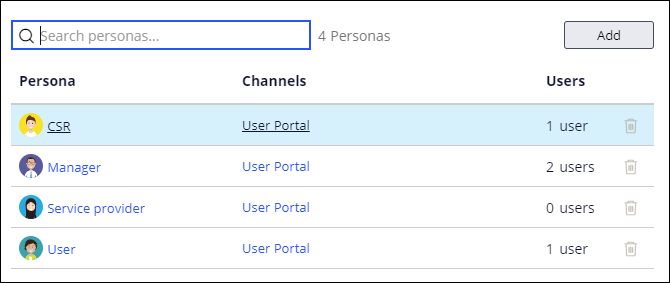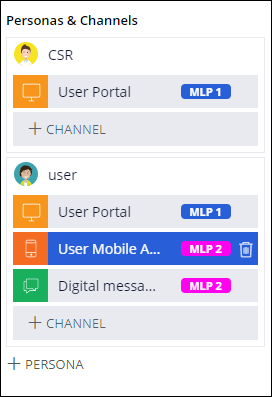
Users and Personas
Applications have users, though not all users perform the same tasks. For example, Service Representative users may access different interfaces and features of your application than a Client user accesses. Pega Platform™ provides a User Management feature to help you organize the users of your application into personas that share common application security and assignments.
Note: Assigning users to appropriate personas is only one aspect of securing an application. For a complete list of security leading practices, consult the Security Checklist awareness module and the Security Checklist for Pega Platform deployment.
Personas and channel interfaces
Personas
A persona is the business representation of a type of user. Personas allow the organization to identify unique needs for application users, which could include different user interfaces to meet those needs. For example, an organization may define a persona to represent a technician, who needs a user interface that supports performing service tasks.
In App Studio, you can add a new persona by clicking Users > User Management and adding a persona in the Persona tab. Once the new persona is created, you can then assign it to users, as well as further configure the application to meet the persona's needs.
Note: Organizations may create multiple personas to reflect different marketing approaches that may not impact application or case design.
Channel interfaces
In Pega Platform, user interfaces are also called channel interfaces. Because the needs of different users require access to different application features, you can configure different personas and channel interfaces. For example, in a healthcare application, patients and doctors must be able to perform different tasks. Patients can check records and schedule appointments. Doctors can review patient records, record prescriptions, and add follow-up comments for patients after office visits.
Define different personas for patients and doctors so that individual users with the appropriate persona specified can see the correct channel interface and access the desired application features.
In the following image, click the + icons to examine how personas can capture interaction needs for different types of users to influence case and application design.
When you create an application, Pega Platform provides one default persona: Users. Users are case participants that are responsible for creating and resolving cases. Create additional personas when a unique combination of channel interface, responsibilities, permissions, and work routing requires differentiation from an existing persona. When you create a new persona, Pega Platform creates default permissions and a work queue for the persona. You can modify the permissions and work queue and create and customize a dedicated channel interface.
Associate a persona to the channel interfaces that best satisfy the needs of the persona. Multiple personas can share a channel interface if appropriate. For example, the Users persona shows the User Portal channel as an interface, which is shared with the customer service representative (CSR), Manager, and Service provider personas.
Configure persona and channel access for each stage in the case life cycle.
User management
A user is an individual who interacts with an application. In App Studio, create a new user with an email address and assign them a persona or developer role by clicking Users > User management > People.
Note: Individuals invited to an application are assigned a developer role so that they can execute the tasks required to fulfill their their job duties. In Pega Platform, a persona is a broad user group created in App Studio that includes an associated role. A role is accessible in Dev Studio and identifies the specific tasks a user is allowed to perform in an application. Each persona created in App Studio has an associated role but not every role has an associated persona.
In the center of the following image, slide the vertical line to see how you invite users to the application and assign them the persona of Testers.
Note: Creating generic account names such as admin is not a best practice. All user accounts should be unique to a specific person.
Check your knowledge with the following interaction:
This Topic is available in the following Module:
If you are having problems with your training, please review the Pega Academy Support FAQs.
Want to help us improve this content?


